How to Craft the Perfect Meeting Request Email (4+ Examples)
Master the art of communication with our guide on crafting the perfect meeting request email. Explore our effective templates and real-world examples.

Messaging back and forth with anyone — especially coworkers — can be a cumbersome process. Rather than overwhelming a sender with multiple email responses, it can be much simpler to just schedule meetings. A meeting request email is an effective way to establish a place and time to gather colleagues or even potential business partners to make collaborative, action-based decisions.
Often, decisions need to be made in real-time, which sometimes can't happen over messaging or social media. Effective meeting request emails can help you nail down a time to talk to the invitee and work through more complex projects. Read on to learn about the anatomy of a meeting request email and look at some meeting request email samples.

When to Send a Meeting Request Email
Several instances merit a meeting request email. For example, you may need to collaborate with your boss over specific items that would be difficult to discuss over email or other media. Meeting invitation emails are constructive when clarification between two or more people is needed. You also may need to contact another organization over a business prospect through an outreach email. Often, in-person meetings let you express yourself clearly and allow for a more flexible meeting agenda. Conversations that require real-time decision-making or plenty of back-and-forth between two or more people, whether at a cafe or on Zoom, often are much better in person. These face-to-face meetings can also be crucial when addressing severe pain points in a project or maintaining professionalism with new clients.
If you suspect a conversation may require several or more emails, it may be worth creating a meeting to mitigate the back and forth. That being said, consider whether or not your potential meeting hits those criteria before sending your email. Sometimes, conveying general information, especially if that information is a singular idea, can be done more effectively over email. Large, complex, and specific ideas are the best topics to go over in your meetings. You also want to be respectful of others' time.

Anatomy of a Meeting Request Email
With a meeting invitation email, you give yourself the opportunity to select your words and structure your phrases thoughtfully and efficiently to get your point across. Take this extra opportunity to your advantage. The following is a broad outline of a typical business meeting request email to get you started.
Attention-getting subject line
Begin your email with an attention-getting email subject line informing your recipient exactly what to expect when they open their message. Making your subject line something that conveys urgency and is clear about the importance of the meeting will increase the likelihood that the recipients will open the email. Email open rates can be difficult, so make sure your email doesn't get lost in the shuffle due to a bland and general subject line.
Short introduction
Follow your subject line with a short introduction to set the tone and expectations. If you have never met your intended recipient, only include information directly pertinent to them, such as your full name and company name, and let the recipient know where you got their contact information. People may be guarded when opening a cold email; adding details will help put them at ease, giving you a better chance of a response. For example, adding a link to your LinkedIn Profile can help give you some credibility. You may forgo this option if you know your recipient or have established a rapport.
Meeting purpose
Following your introduction, give a general overview of the topics you want to discuss in your meeting and what you hope to achieve. Briefly delineate how these topics could relate to their priorities. If you can, create a short agenda of the issues you want to discuss so that the meeting runs smoothly and no one is confused by the purpose.
Request with precise availability times and a location
Offer a time frame for the meeting dates and a location or meeting link (if speaking virtually). Calendly is a great resource where people can pick a time on your calendar that is open. Once you have this last part of your email down, add a conclusion giving your best regards and leave your essential information for the recipient.

Tips for a Successful Response
It can be challenging to get a response, especially when we receive so many emails in our day-to-day lives. Luckily, you can take steps to ensure a reply better and get that meeting set.
Relieve your recipient from having to do too much planning. Instead, offer them two or more choices of time, such as "I'm available tomorrow and Friday," and come up with a selection of venues. Then, ask if the choice of time and venue is convenient. Take the initiative and allow yourself to be flexible if the client has a suggestion. At this point, you already involve them, which is a great way to garner a response. You can expand on this involvement by asking them questions or requiring a confirmation email or rsvp. In either case, you've established that a reply is expected.
Personalize the greeting
Personalize your email to the recipient. In an office setting where you email your colleagues, let everyone know why their input would be valued, especially if they have unique insight into one or more topics you wish to cover. If you send the invite to just one person, include their first name in the message or subject line.
Triple-check the recipient's exact name
Remember that when you include someone's name, double-check your spelling when addressing them. Please do not rely on spell check or recall it from memory. It is too easy to misremember a character and start the interaction on the wrong foot by insulting your recipient.
Succinct is better
Your reader will be more likely to respond to a succinct email that is specific and has clear intent. Often, people feel obligated to respond to a lengthy email with equal length. Keeping it relatively short and to the point lets them know that they can respond in kind, significantly increasing the likelihood of a response.
Send it early morning or around lunch in the recipient's timezone
Remember that the earlier time of day you send your email, the better chance you will garner responses. As the day goes on, people often check their email less frequently. Many of us are used to checking our emails right away at the beginning of the workday, making that a great time to get invites out. Lunch is another time when people are more available to check their messages, making it a great time to send out an invite. Be sure to align send times with your recipient's time zone, not your own.
Ask a question to increase response chances
Ask direct, pointed questions to help engage those you send to and increase your response chances. In some instances, consider writing a follow-up, especially if your meeting goals are time-sensitive. By calling out the recipient directly, they are less likely to skim over your invite and more likely to commit to a time to chat.
4 Examples of Meeting Request Emails
To whom you are sending a meeting email, the context determines how to address your recipient, what ground to cover, and the tone. For example, writing to someone you have never met before will require more information about who you are, why you are writing, and commonalities. In contrast, an email to someone you know or a colleague can forgo an introduction. You can add a personal touch to a brief intro and then state your intent and goals. If you and your colleague share the same work-related purposes, inform them how a meeting could help expand on present ideas or create new ones. If you are writing on behalf of someone like a manager, be sure to include that. Here are a few sample emails you can use as meeting request email templates:
General cold meeting request
Dear [name of recipient],
My name is [your name], writing on behalf of [your company name or manager's name]. Here, we specialize in . . .
We heard about you and your company through [reference]. Since you're an [position] at [company name], I would like to set up a time to discuss [general outline topics of meeting] and collaborate face-to-face or on Zoom.
If face-to-face is your preference, I would like to invite you to our office at [address] for a meeting to discuss this more. Would [two choices of date and time] work with your schedule?
Let me know if you have any questions, need further information, or if you would like to schedule a different time.
Kind regards,
[your name]
Formal meeting request (with someone you know)
Dear [recipient],
I thought it would be good to schedule a meeting to go over [outline intent and goals of engagement]. I recommend [two suggestions for dates and times] at this location. Is this something that works for your schedule?
Kind regards,
[your name]
Informal meeting request (with someone you know)
Hi [recipient’s name],
Hope you're doing well! I'm reaching out to get a meeting going concerning [main topic and goals of meeting] at [location and two choices of time]. Is this convenient for you?
Would you mind confirming your availability and preference if you'd like to change location?
Best,
[your name]
Meeting request with someone you've recently met
Hi [recipient’s name],
I would like to continue our discussion by setting up a follow-up meeting at [location and two date and time choices].
Please confirm your availability and preference if you'd like to change location.
Regards,
[your name]

Frequently Asked Questions
Here are answers to some frequently asked questions about meeting request emails:
Can you have a meeting by email?
Generally, a meeting involves real-time communication between two or more parties. Because email is an asynchronous means of communication, it's not suited for meetings. If your email client is through G Suite or Gmail, it may be possible to transition an email to an appointment using Google Teams.
Why is a meeting better than an email?
A meeting is not necessarily better than an email. Often, a well-crafted email can save others' time and effectively communicate necessary information. Before requesting a meeting, ask yourself whether the salient information can be transmitted via email.
For more complex concepts that are difficult to share via pure text but can be delivered asynchronously, consider using tools like Loom, which can cut down on meeting spam so that you can be respectful of coworkers' and clients' time.
When should I use email vs a phone call?
Generally, a phone call is better suited for discussions of more complex concepts that require immediacy. Consider using a messaging app for quick questions that can be answered immediately.
How do you ask someone's availability for a meeting?
In our experience, asking for someone's availability is difficult. Instead, responses are generally better when the meeting requester offers initial availability slots to choose from. Another helpful tip is to use a calendar app so that the recipient can select an available time slot on their own. This method dramatically increases the likelihood of a meeting conversion.
How do you send a meeting invitation via email?
Each email platform has a slightly different process:
How to send a meeting invitation via Microsoft Outlook
In Outlook, when you create an email, you can select the "Message" tab at the top and then click the "Meeting" option within the "Respond" group of options. Then, a meeting scheduling popup will appear, letting you input your start time, end time, recipients, and information. You can then send this, and the recipients can suggest alternate times if your suggestion doesn't work for them.
How to send a meeting invitation via Gmail
When sending a meeting invitation through Gmail, there isn't an integrated feature that works quite as smoothly for setting up meetings. You can use a link to your Calendly to expedite scheduling. Alternatively, if you go to your Google Calendar, create a meeting time, then select the Pencil icon when you click on that meeting, you can add guests and meeting details to schedule your meeting.
Summary
A meeting request email personalized to the recipient, structurally sound, and succinct can be the perfect way to get you closer to that face-to-face exchange, virtual or otherwise. Sending a clear meeting invitation message will help you cut through the long threads of back-and-forth emails that can delay projects and flood your inbox. Consider utilizing a third-party application like Calendly or Portal to make scheduling meetings and sending client messages streamlined and smooth for you and your team.
Make Client Messaging Easy With Copilot

Copilot is a no-code customer portal solution that lets you offer clients a unified hub for messaging, file-sharing, eSignatures, payments, forms, and self-serve support. Copilot enables you to design a customized client experience that elevates your brand in all customer interactions, including client messaging! Try Copilot for free today.

